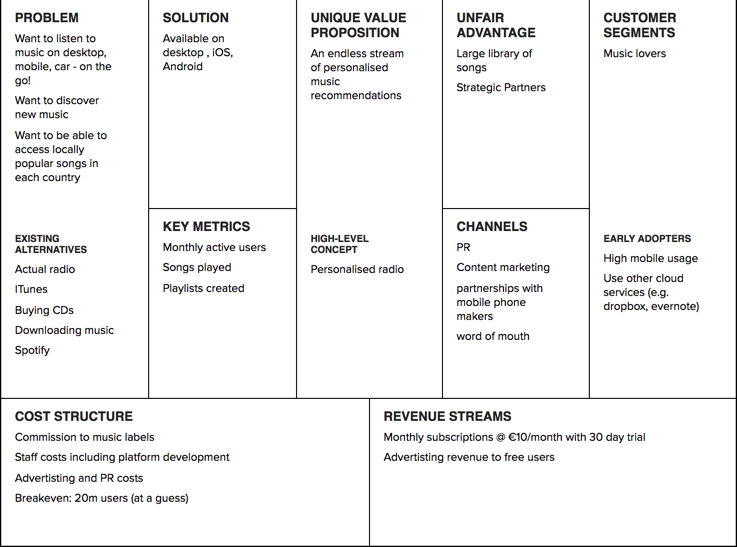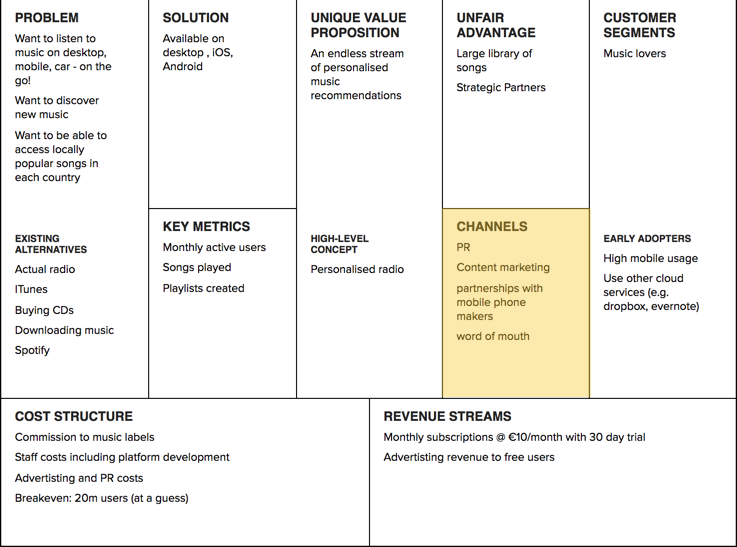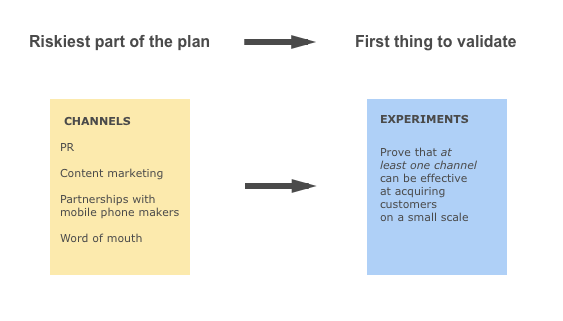One of the main benefits of the Lean Canvas is that it forces you to consider each of the ten elements of a business model. An excellent product does not mean an entrepreneur will be successful. Rather, the product is just one part of the business model (the "solution" part). Completing a Lean Canvas compels you to look at all aspects of the business model, not only the product.
Another of the main benefits of the Lean Canvas is that it can help you identify the next actions to take for a fully validated business model. Ash Maurya suggests the following actions in order:
Complete a Lean Canvas.
Identify the riskiest part of the plan (the section of the Lean Canvas where you have least confidence in the information you filled in).
De-risk this part of the plan by running some experiments to validate some of your assumptions.
Let's have a look at this process in action through an example.
Example of a completed Lean Canvas
Let's look at an example of a Lean Canvas that I have filled in for the music streaming service Deezer.

You may already have noted that Deezer is a mature business. Although they have validated their business model, this is a good example of a completed Lean Canvas.
Identify the riskiest part of the plan
The next step is to choose a part of the plan that I think is the "riskiest."
I choose the "Channels" section of the Lean Canvas as the one where I have the least certainty. When I completed this section, I stated that our business model assumed we can acquire paying customers through PR, content marketing, and partnerships. However, I am not really certain that this is the case, and I identify this section as the riskiest.
So, I highlight this section in yellow to denote that it is the riskiest part of the plan:

Validate your assumptions
Now that I have identified the "riskiest part of the plan," I ask myself, "How can I validate my assumption that we can get paying customers through PR, content, and partnerships?" This is an excellent question to ask, and the answer in real life comes from a discussion with your team members, experts in the field and your own domain knowledge. At least you know the first thing you wish to validate about the plan; this is an excellent guide to your next activity as a team.

Lean Startup
When we speak in the above section about running an experiment to prove a hypothesis, what we really mean is trying something on a small scale (e.g., spending $100 on Google Ads) to prove that something is possible on a larger scale.
But how do we design an experiment? What does it look like? How do we know if it is a success or a failure? These are all questions that are incorporated into a framework for accelerated learning, and continuous improvement called Lean Startup.
Applying Lean Startup principles to run an experiment would look like the cycle below. You can read more about it online - or check out the next course in the product management path, and you'll see how this is an ideal way to validate an existing hypothesis.

Let's recap!
The Lean Canvas has several very useful applications.
It forces us to think not only of the product (one part of the business model) but also each of the ten major elements of a business model - and to give each element at least some consideration.
It allows you to update your business model in a lightweight fashion as it changes.
It enables you to think about how many users are required for breakeven.
It allows you to choose the weakest or riskiest part of the plan and to take action and accelerate learning through a deliberate strategy of validating the assumptions that are the least reliable.
